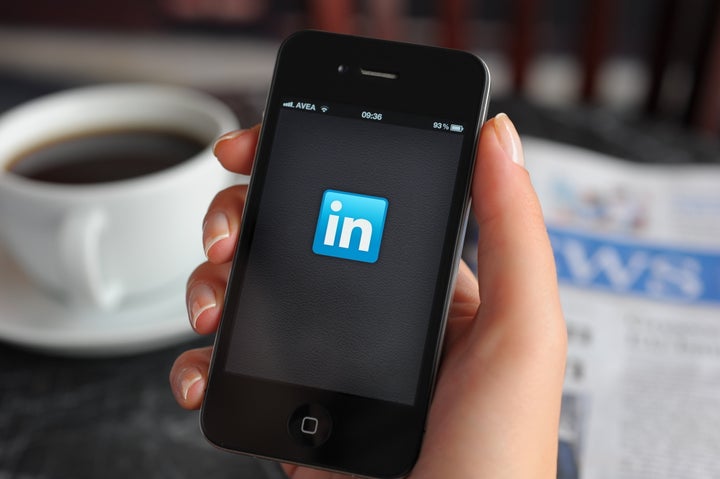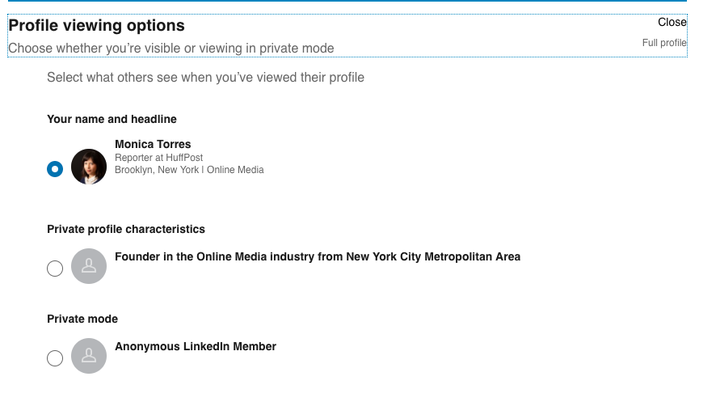
I don’t know who needs to hear this right now, but your LinkedIn actions are not necessarily private. As a social network for job seekers and a database for recruiters, LinkedIn is a place where professionals can both connect with future employers and check out old colleagues, high school classmates and exes.
But if you check out your old college boyfriend without taking steps to conceal yourself, he’ll know you looked him up. And if your goal is to quietly switch jobs, know that your job hunt can become public with LinkedIn connections.
Take this cautionary tale detailed by The Wall Street Journal: After being contacted by a recruiter on LinkedIn, Houston consultant Joshua M. Evans found out his job search had been revealed by a LinkedIn notification. Evans hadn’t turned off his LinkedIn notifications to his network, so his boss saw his new connections with the recruiter and two managers at the company where he was applying. It created “a very awkward situation,” Evans told the Journal.
How to keep your LinkedIn connections more private
Who you are connected with can be valuable information. Beyond snoopy bosses, there are also snoopy recruiters, and maybe you don’t want someone mining your network for potential hires without going through you first. If you want to keep your connections private for either reason, go to your LinkedIn account:
- Click “Settings & Privacy.”
- Select: “How others see your LinkedIn activity.“
- Choose who can see your list of connections and select “Only you.”
Maybe you don’t want your current employer to know you’ve been polishing up your LinkedIn bio. If you want to keep your activity notifications more private from curious employers on LinkedIn:
- Under “Settings & Privacy,” select: “How others see your LinkedIn activity.“
- Select “Share job changes, education changes, and work anniversaries from profile.“
- Choose no when it asks if you want your network to be notified about activity.
Strategies behind going private on LinkedIn ... or staying public
One key feature on LinkedIn is that you can see who has viewed your profile, depending on their privacy setting. For example, if I click on a hiring manager’s LinkedIn profile and my profile views are set to public, they can see that I looked up their profile. If you’re a job seeker, keeping your profile views public can signal your willingness to be contacted about jobs.
You can also signal this desire more directly to recruiters. When you set up your profile, you can click “Looking for job opportunities,” then choose to let either only recruiters or all LinkedIn members know that you are interested in switching jobs, and what kind of jobs you want.
Ilana Gershon, an anthropology professor at Indiana University and the author of “Down and Out in the New Economy: How People Find (or Don’t Find) Work Today,” interviewed job seekers who use LinkedIn for her research. “If you go fairly public and you have a set of skills that recruiters are often looking for, that is a sign that you are an active-passive seeker,” Gershon said. “You are interested in having recruiters approach you. You may not necessarily be applying for jobs.”
Gershon said that limiting available information by going private or semiprivate is another job-search strategy some people use: By withholding information on LinkedIn, like how you appear on viewer lists and what you list in your profile, the theory goes, you entice people in hiring positions to reach out to learn more about you. “The privacy settings on LinkedIn, when you’re doing semiprivate or private, are kind of functioning like the reverse of the thirst trap in which you’re trying to withhold information so that people want to contact you,” Gershon said.
To choose private mode:
- Under “Settings & Privacy,” select: “How others see your LinkedIn activity.“
- Select profile viewing options to choose to be public, semiprivate with general details of your industry, or private.

LinkedIn states that in this private profile viewing mode, “No other information about you will be shared with the member whose profile you viewed,” and your viewer history will be erased.
If you choose semiprivate, your “job title, company, school, and industry will be shown to the member you are viewing” so that the person can see, for example, that a consultant at State Farm or someone at Accenture has peeked at their profile, according to LinkedIn.
Beyond limiting what information is displayed on your profile when you view someone else’s profile, you can also limit what is seen when someone uses a search engine that turns up your profile. To do that, go to your profile settings and decide if you only want LinkedIn members directly connected to you, all LinkedIn members, or the general public to see information like your bio, summary, the articles you are reading on LinkedIn, and current and past experience.
Using an incognito browser may not help you stay private
If you are job hunting on work equipment, incognito web browsers can help you keep your search under wraps. You don’t want your browser history to reveal your LinkedIn searches, after all. On an incognito web browser, you can run LinkedIn searches of people you want to work for without using your LinkedIn account.
But here is an important caveat. Although going incognito prevents your web browser from saving your search history, the websites you visit are still collecting your activity like normal. If you don’t want people to know you viewed them, you must be logged out of your LinkedIn account, even in an incognito browser. Trust me: I tried snooping on two of my colleagues’ accounts in a private browser window and both of them saw that I had viewed their profiles because I was still logged in on LinkedIn.
Now let’s take the scenario in which you’re opening a private tab on your mobile phone browser to search for a person’s LinkedIn page. If you have the LinkedIn app installed on your phone, you will get a prompt that asks, “Open in LinkedIn?” Maybe you are too quick to click affirmatively, like I was, and suddenly you are on the LinkedIn app with whatever default settings you have. For me, the default setting is public, so my work to stay incognito was all for naught.
Staying completely undercover, in other words, means not only taking into account who sees your profile and how, but also with whom you are connected and if you are logged into LinkedIn. Always check your default privacy settings on social networks, job seekers!